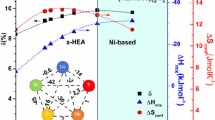Abstract
Four sets of ternary Ni-Nb-Ta multilayered samples with overall compositions of Ni69Nb8Ta23, Ni55Nb13Ta32, Ni42Nb16Ta42 and Ni29Nb18Ta53, respectively were prepared and subjected to 185 keV xenon ion beam mixing. The experimental results showed that in the four Ni-Nb-Ta multilayered samples, metallic glasses could all be obtained at appropriate doses, supporting the prediction directly from a proven realistic Ni-Nb-Ta interatomic potential through molecular dynamics simulations, and that two different atomic structures were observed, as in the corresponding selected area diffraction patterns, the locations of the diffused bands reflected from the metallic glass phases were observed at different angles for the Ni69Nb8Ta23 and Ni29Nb18Ta53 metallic glasses. Interestingly, Voronoi tellessation analysis indicated that the observed difference in atomic structures could be attributed to the distinct coordinate number spectra, i.e., the spectrum of the Ni69Nb8Ta23 metallic glass has its coordinate number (CN) equal to 13 as dominating atomic configuration (with a weight of about 27%), whereas for the Ni29Nb18Ta53 metallic glass, CN=14 is the dominating atomic configuration (also about 27%). Moreover, the distinct atomic configurations of the obtained Ni-Nb-Ta metallic glasses could be correlated to the structures of the constituent metals of the ternary Ni-Nb-Ta system, as the first neighbor of fcc is 12 and the sum of the first and second neighbors of bcc is 14, implying the structural heredity did play a role in metallic glass formation.
Similar content being viewed by others
References
Klement W, Willens R H, Duwez P. Non-crystalline structure in solidified gold-silicon alloys. Nature, 1960, 187(4740): 869–870
Lu Y Q, Zhu Y Y, Chen Y F, et al. Optical properties of an ionic-type phononic crystal. Science, 1999, 284(5421): 1822–1824
Koch C C, Cavin O B, Mckamey C G, et al. Preparation of amorphous Ni60Nb40 by mechanical alloying. Appl Phys Lett, 1983, 43(11): 1017–1019
Liu B X, Lai W S, Zhang Q. Irradiation induced amorphization in metallic multilayers and calculation of glass-forming ability from atomistic potential in the binary metal systems. Mat Sci Eng R, 2000, 29(1-2): 1–48
Li J H, Dai Y, Cui Y Y, et al. Atomistic theory for predicting the binary metallic glass formation. Mat Sci Eng R, 2011, 72(1-2): 1–28
Li Y, Wang T L, Ding N, et al. Metallic glass formation in the ternary Ni-Nb-Mo system by ion beam mixing. Sci China Tech Sci, 2012, 55(8): 2206–2211
Dai Y, Li J H, Che X L, et al. Glass-forming region of the Ni-Nb-Ta ternary metal system determined directly from n-body potential through molecular dynamics simulations. J Mater Res, 2009, 24(5): 1815–1819
Ziegler J F, Biersack J P, Littmark U. The Stopping and Range of Ions in Solids. Oxford: Pergamon, 1985
Dai X D, Kong Y, Li J H. Long-range empirical potential model: Application to fcc transition metals and alloys. Phys Rev B, 2007, 75(10): 104101
Dai X D, Li J H, Kong Y. Long-range empirical potential for the bcc structured transition metals. Phys Rev B, 2007, 75(5): 052102
Parrinello M, Rahman A. Crystal-structure and pair potentials-a molecular-dynamics study. Phys Rev Lett, 1980, 45(14): 1196–1199
He J H, Ma E. Nanoscale phase separation and local icosahedral order in amorphous alloys of immiscible elements. Phys Rev B, 2001, 64(14): 144206
Luo W K, Sheng H W, Alamgir F M, et al. Icosahedral short-range order in amorphous alloys. Phys Rev Lett, 2004, 92(14): 145502
Thompthon M W. Defects and Irradiation Damage in Metals. London: Cambridge University Press, 1969
Russell K C. Phase-stability under irradiation. Prog Mater Sci, 1984, 28(3-4): 229–434
Tai K P, Gao N, Dai X D, et al. Icositetrahedral and icosahedral atomic configurations observed in the Nb-Ag metallic glasses synthesized by ion beam mixing. Appl Phys Lett, 2006, 89(9): 094108
Author information
Authors and Affiliations
Corresponding author
Rights and permissions
About this article
Cite this article
Wang, Y., Liu, J., Dai, Y. et al. Different atomic structures observed from ternary Ni-Nb-Ta metallic glasses obtained by ion beam mixing. Sci. China Technol. Sci. 56, 1842–1846 (2013). https://doi.org/10.1007/s11431-013-5214-5
Received:
Accepted:
Published:
Issue Date:
DOI: https://doi.org/10.1007/s11431-013-5214-5




